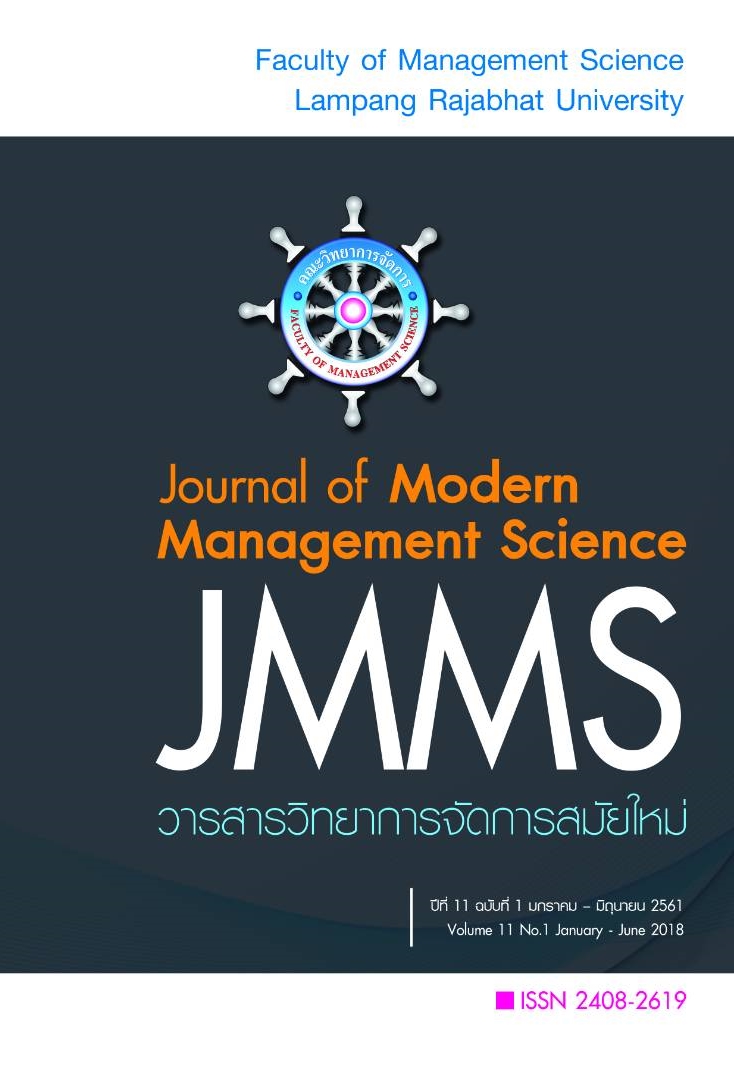Factors Affecting Business Capacity of the SMEs Entrepreneur for Digital Economy in Thailand.
Main Article Content
Abstract
This research aims to study factors which affecting business capacity of the SMEs entrepreneur for digital economy in Thailand. This research is conducted in both quantitative and qualitative aspects. The 400 SMEs entrepreneur are sampled from the SMEs in 4 provinces namely: Ayuttaya, Nontaburi, Pathumtani and Saraburi.The data is analysed using the Structural Equation Model. The results show that the empirical data are consistent with the modelling data.
The result of this research indicated that the two factors which directly affect the business capacity of SMEs for the digital economy are namely “sustainability of SMEs” and “product development”. The other two indirect factors are “human resource management” and “marketing management”.
In conclusion, the Business competitiveness and sustainability in Digital Economy could be achieved, the SMEs should be able to access the government service, to manage with technology system, a working capital at a low cost of fund product quality and standard certified innovative and differentiate creative thinking digital marketing (online/e-commerce)
Article Details
The article must be considered and accepted for publication by the editorial board of the Faculty of Management Science, Lampang Rajabhat University. The articles have been reviewed by a peer (peer review) and the author must update according to the suggestion if available before publication. Articles that are not considered the editorial team will inform the results of the consideration but will not send the original to the author.
JMMS is the Faculty of Management Science journal, Lampang Rajabhat University. Jmms published both print and online editions. We allow the use of articles for academic use under the scope of copyright law.
References
ชัยสมพล ชาวประเสริฐ. (2547). การตลาดบริหาร. กรุงเทพฯ : ซีเอ็ดยูเคชั่น.
ณัฎฐพันธ์ เขจรนันท์ และคณะ. (2545). การบริหารความได้เปรียบทางการแข่งขันเพื่อความสำเร็จในการ
ดำเนินงานของธุรกิจ SMEs ในเขตภาคเหนือ ของประเทศไทย - วารสารวิทยาการจัดการ, น.189 .
สำนักงานคณะกรรมการพัฒนาการเศรษฐกิจและสังคมแห่งชาติ. (2550). ปรัชญาของเศรษฐกิจพอเพียง. กรุงเทพฯ:
โรงพิมพ์ 21 เซ็นจูรี่.
ณัฐเชษฐ์ พูลเจริญ, พยอม วงศ์สารศรี,นวพร ประสมทอง, กังวาน ยอดวิศิษฎ์ศักดิ์ (2014). โมเดลสมการโครงสร้างปัจจัยที่ส่งผลต่อความสำเร็จในการจัดการความรู้ของวิสาหกิจขนาดกลางและขนาดย่อม (SMEs) กลุ่มอุตสาหกรรมอาหารและเครื่องดื่มในประเทศไทย - Journal of Business.,2016,113-126
ธานินทร์ ศิลป์จารุ. (2552). ความสัมพันธ์ระหว่างการประยุกต์ใช้ข้อมูลการบัญชีบริหารกับความสำเร็จในการ
ดำเนินงานของธุรกิจ SMEs ในเขตภาคใต้ - วารสารวิจัยและ พัฒนาวไลยอลงกรณ์, ปีที่ 11 ฉบับที่ 2 น.373-383
นภดล เหลืองภิรมย์. (2555). การจัดการนวัตกรรม. กรุงเทพฯ : ดวงกมลพับลิชชิ่ง.
บุษกรณ์ ลีเจ้ยวะระ. (2559). Competitiveness ขีดความสามารถในการแข่งขัน. สืบค้นเมื่อ กรกฎาคม 21, 2559, จาก http://www.isaanbizweek.com/competitiveness
พงศ์ศรันย์ พลศรีเลิศ. (2556). การสร้างมูลค่าเพิ่มให้กับธุรกิจ. สืบค้นเมื่อ กรกฎาคม 20, 2559, จาก
https://phongzahrun.wordpress.com/
พัชสิรี ชมพูคำ. (2553). องค์การและการจัดการ. กรุงเทพฯ : สำนักพิมพ์แมคกรอฮิล
วรากร สามโกเศศ. (2557, 23 กันยายน). Digital Economy. กรุงเทพธุรกิจ, คอลัมน์อาหารสมอง
วิลัดดา เตชะเวช. (2547). คุณค่าการตลาดท้าทายความสำเร็จธุรกิจยุคใหม่. กรุงเทพฯ : มหาวิทยาลัยธรรมศาสตร์.
เศรษฐพงค์ มะลิสุวรรณ. (2560). ทำลายล้างธุรกิจ. สืบค้นเมื่อมิถุนายน 1, 2560, จาก http://www.smmagonline.com/2017/01/04/internet-things-iot-ในปี-2017
Don Tapscott. (1995) The Digital Economy : Promise and Peril in the Age of Networked Intelligence .
Khalili et al. (2013). The influence of entrepreneurial orientation on innovative performance Journal of Knowledge-based Innovation in China, Vol. 5 Issue : 3, p. 262-278
Kitson, M., Martin, R. & Tyler, P. (2004). Regional Competitiveness : An Elusive Yet Key Concept?. Regional Study. 38(9), 991–999.
Kotler, P. (2003). Marketing Management (11th ed.). New Jersey: Pearson Education.
Kotler, P., & Keller, K. (2009). Marketing Management (13th ed.). Pearson Prentice Hall.
Mc Carthy., & Perreault, Jr. (1995). the Dynamics of the Marketing Orientation in Transition Economies:
A Study of Russian Firms, Journal of International, 3, No.2.
Mowery, D. C., & Rosenberg, N. (1978). The Influence of Market Demand Upon Innovation: A Critical. Review of Some Recent. Reindustrialization and Technology - Page 81
Myers, S., & Marquis, D. G. (1969). Successful industrial innovations : a study of factors underlying innovation in selected firms. Washington, D.C. : National Science Foundation, 69-17
Nunnally., & Bernstein. (1994). The Assessment of Reliability. Psychometric Theory, 3, 248-292.
Orji & Goodhope. (2013) Major Classic Consumer Buying Behaviour Models: Implications for Marketing Decision-Making. Journal of Economics and Sustainable
Porter, M. E. (1998). Location, Clusters and the New Economics of Competition. Business Economics,
33, 7-17.
Porter, M. E., & Van der Linde, C. (1995). Competitiveness Relationship. Journal of Economic Perspectives, 9(4, fall), 97-118 :
R.A.Noe, J.R. Hollenbeck, B.A. Gerhart & P.M Wright, (2003). On Becoming a Strategic Partner: The
Role of Human Resources in Gaining Competitive Advantage Human Resource
Management (1986-1998); New York Vol. 37, Iss. 1, (Spring 1998): 31
Ringer, D. (2015). 3 Reasons Why Product Development is Important. Retrieved October1, 2016,
from https://www.pddnet.com/blog/2015/09/3-reasons-why-product-development-important
Schmookler, J. (1962). Changes in Industry and in the State of Knowledge as Determinants of
Industrial Invention (NBER Chapters) (pp. 195–232). National Bureau of Economic Research, Inc. Retrieved March 2, from http://ideas.repec.org/h/nbr/nberch/2118.html
Smith & J. Walker. (1991). Beyond Anecdotes : Toward a Systematic Model of the Value of Marketing Research,44, 51-65.
Tabachnik., & Fidell. (2007). Multivariate analysis of variance and covariance Retrieved January 23, from https://www.researchgate.net/.../279972004_Multivariate _Analysis_of_V...


